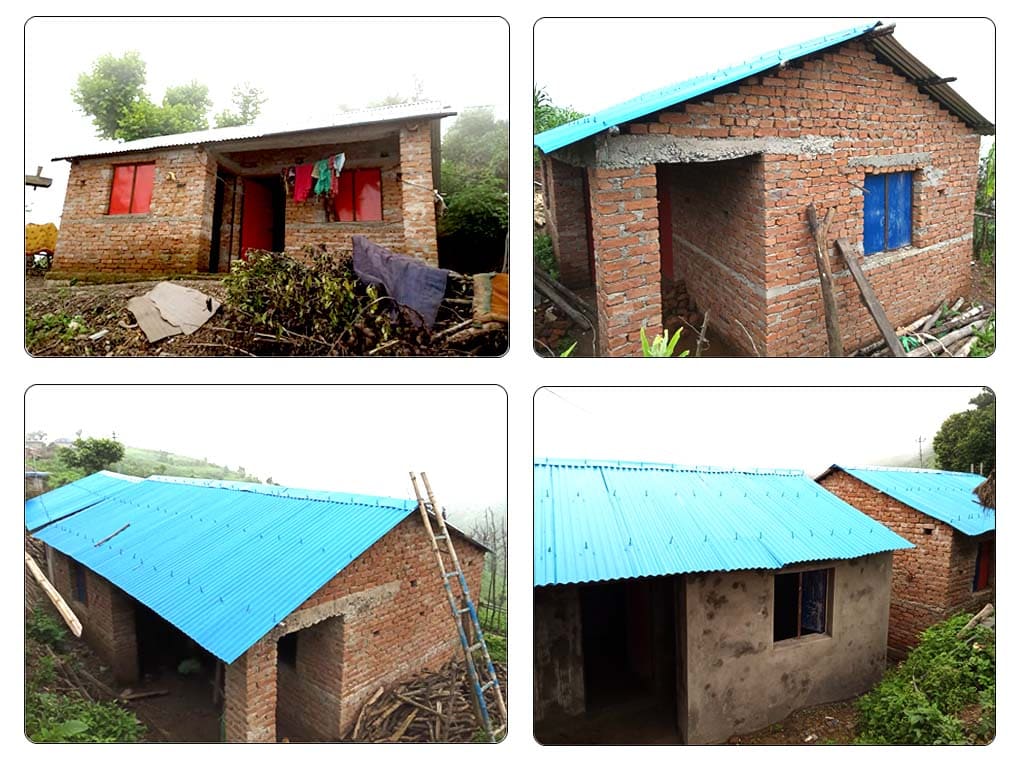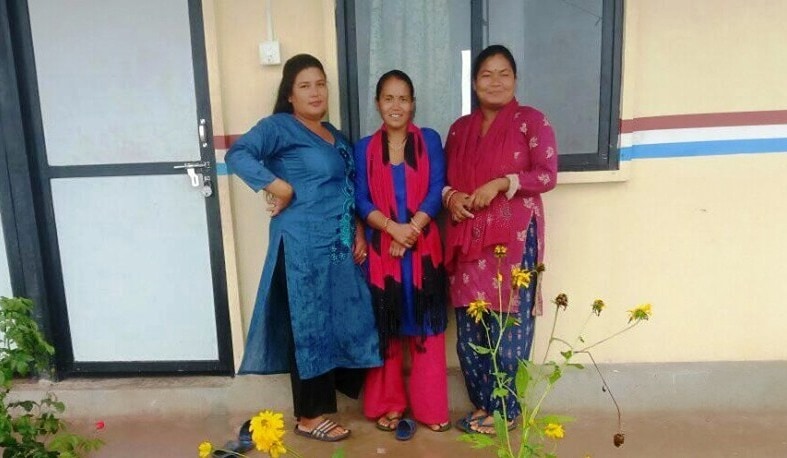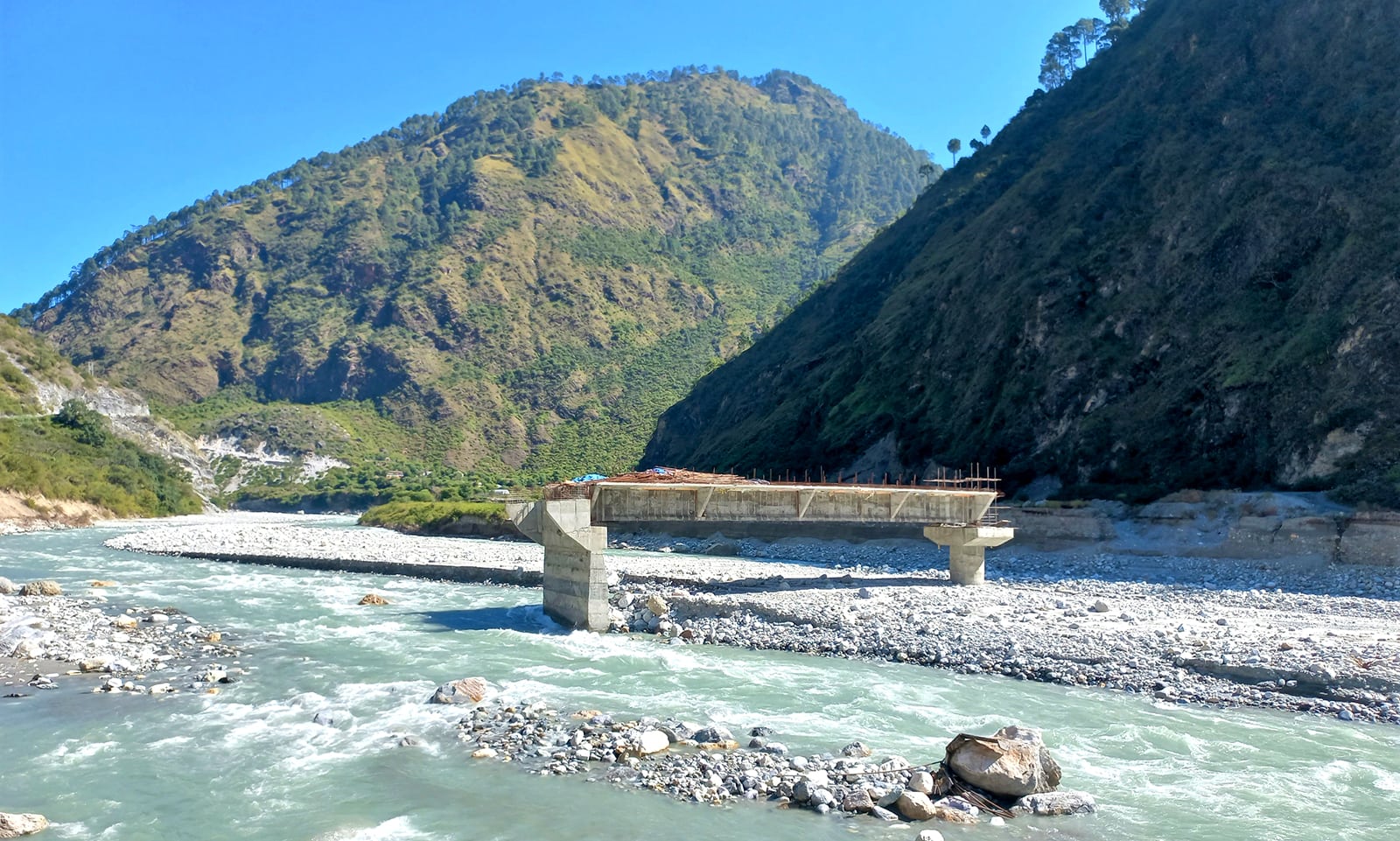The targeted group are reluctant to stay in the government-funded prefab houses as they have been found to be ineffective to achieve the desired purpose in the rural municipalities.
Devendra Basnet: Centre for Investigative Journalism-Nepal
In a bid to relocate people of the underprivileged communities, the Bangalachuli Rural Municipality–north-east of Dang’s Ghorahi–constructed 30 houses under the ‘Namuna Basti’ (Model Village) project in the fiscal year 2018/19.
The Federal Government earmarked Rs 20 million to the rural municipality as financial support while the latter apportioned Rs 10 million to construct 30 prefab houses each with two rooms.
The Bangalachuli Rural Municipality, meanwhile, allocated Rs seven hundre to the construction company for each prefab house, which locals complain was much higher than the amount that was spent to construct a two-roomed cemented house previously constructed by the rural municipality.

House constructed in Banglamukhi-2 in Rs. 5 lakh, including the people’s labour contribution. Photos: Devendra Basnet
The rural municipality had constructed 15 two-roomed cemented houses 2 at the cost of Rs 500 thousand each – with Rs 332,500 from the rural municipality and the rest through people’s contribution – in ward no 2.
Deputy Chief at the rural municipality, Yamuna Ghatri expresses astonishment saying, “This sounds weird. How can the cost of a prefab house be Rs 700 thousand when the rural municipality has constructed a cemented house at Rs 500 thousand?”
Ironically, it’s been two years that the prefab houses have been constructed under the ‘Namuna Basti’ project. However, no ‘underprivileged’ people are willing to move into these houses as these structures are not properly built. Therefore, most of the houses constructed by the ‘Mine Stone’, a construction company, are abandoned.
Among the six construction companies bidding for the contract, the ‘Mine Stone’ had won the bid as the other five companies lacked prior experience in construction, according to rural municipality administrative officer Neb Bahadur Oli.
Mine Stone company chief, Yagya KC says the rural municipality had allocated Rs 25.8 million to construct 30 prefab houses. KC admits that the cost has been higher due to the adverse geographical location.
“Had it been in the plains or accessible location, the cost would have been lesser, he claimed. The rural municipality further claims it spent a total of Rs 4.2 million to construct 15 toilets for 30 prefab houses.
However, what has to be noted emphatically is that the construction cost of 30 houses will not in any way total to Rs 6 million even if an additional Rs 200 thousand for each house is added.
“Construction of each house of this kind with two rooms will not exceed Rs 500 thousand,” says Yogendra GC, an engineer in Dang, adding, “Rs 7 lakh is beyond the limit.”
Sub-Engineer Dharma Acharya, too, concurs with GC saying that the expenditure was too high. “Each house of this kind can be constructed at Rs 400 thousand. The construction cost of Rs 700 thousand for this kind of house is unexceptionally high.”
According to Suresh Basnet, the supplier of the construction materials, too, is not convinced that the rural municipality spent Rs 700 thousand for each house. “It will not exceed Rs 550 thousand to construct a prefab house with two rooms,” he said, sharing his experiences.

Sarita Oli, Uma Oli and Shanta KC. The three have been living in prefab houses in Banglachuli-5.
Despite such high costs, these houses are not accommodation-friendly as they are not properly constructed. Moreover, despite the construction some 19 months ago, the rural municipality is yet to hand over the houses to the targeted group. For instance, people are unwilling to shift to the six houses constructed in the jungle of Haansipur-8 of the rural municipality.
It should be noted that the rural municipality had entrusted the ward-8 authorities to identify the underprivileged people in the ward and hand over the prefab houses to them. “Unfortunately, not a single family is willing to stay in the house,” says ward Chairperson Giriraj Bantha, adding, “The houses, therefore, are still vacant.”
Hansipur Rural Municipality invested Rs 5.5 million to construct six prefab houses, a toilet and to install a solar panel. However, due to the lack of drinking water, people preferred not to stay in these houses as they would be compelled to walk for three hours to fetch drinking water from there.
Forget about drinking water, the houses built in an area far from human settlements, are not residence-friendly. According to Neb Bahadur Oli, administrative officer of the rural municipality, problems have emerged as the workers failed to fill the land site properly. “Problems arose as the houses were built in a rushed manner without filling the construction site,” he said.
Six houses constructed at ward-2 of Badipokhari are also abandoned. Six families, supposed to get the house, expressed their unwillingness to stay there. “All the houses have been unoccupied as people are reluctant to stay there,” ward Chairman Meghraj Rana said. Moreover, the houses are far away from the village as it nearly takes more than an hour to reach there on foot making it difficult for daily-wage workers to travel every day stirring the fear of losing their earnings.
The new prefab houses, meanwhile, failed to fascinate people who owned a plot of land in the village. Even though the ward has categorized people having less than one ropani of land as ‘poor’, people falling under this category are reluctant to leave their settlement. Says ward Chairman Rana, “People accustomed to tilling their own land are not willing to shift to the new house. The houses that we constructed have been a complete waste.”
Similarly, eight houses constructed at ward-4 of Bangalachuli, too, have been abandoned. According to Narayan Dangi, the ward Chairman, despite showing their willingness to shift to the new houses by filling up the forms, people did not turn up.
“If the details of the rural municipality are to be considered, a total of Rs 5.6 million has been expended to construct those houses,” he said. Moreover, the houses are built wrongly. While tin sheets have been fixed on the roof, the walls are not properly positioned. Locals fear that the government houses cannot endure strong wind or heavy rains.
Says Yamuna Gharti, Deputy Chief of the rural municipality, “Initially, the houses looked attractive. However, later we realized that there were lapses.” Locals smell a rat in the construction saying that there has been misappropriation of funds in the project.
However, Chairperson of the rural municipality Bhakta Bahadur Oli dismisses allegations of budget misappropriation while constructing the houses. He, however, admits that the costs exceeded owing to ignorance. “I think the cost is not too high as assumed,” he said, hoarding all blame on the administrative officer at the rural municipality. “Since he prepared the budget estimation, he should be knowledgeable about it,” Oli claimed.
Administrative Officer, Neba Bahadur Oli, meanwhile, rejects claims of misappropriation in the project as it was given on a contract. According to him, the ‘Mine Stone Company’ was given the contract as no other construction companies were in the race. “Had there been other bidders, the contractor would have gone to the one bidding the contract at a lower rate, for instance, Rs 400 thousand per each house,” he said.
Woes of the underprivileged
Uma Oli of Bangalachuli Rural Municipality ward no-5 owned a hut built on public land at Jhelneta. The news that the government was providing houses to underprivileged people came as soothing information to landless Uma, a daily-wage worker.

Photo (1): Prefab houses made in Banglachuli-5, which cost Rs. 7 lakh each. Photo (2): Clothes/rags put by the tenants (or householders) in the gap between the corrugated tin sheets and the wall to prevent seepage.
She expressed her willingness to dismantle her hut with the hope of getting a new house. The rural municipality constructed four houses in the same plot where she had her hut. Uma was one of the owners of the new house.
However, she said her previous hut was better than the new house provided by the government. “Staying in this house is harrowing,” Uma, who shifted to the new government house in October 2019, expressed her anguish. She complains that the roof neither blocks the sunlight, nor the rains. “It is terrible when there is rainfall or strong winds,” she complained. “I could not even sleep properly for several days as the rains got inside. I have experienced some sleepless nights with my kid,” she laments.
Uma’s neighbor, Sarita Oli’s woes are no different. She has placed some plastics on the roof to prevent rain and some cardboards on the walls to prevent wind from blowing inside. Pointing at the plastic on the roof, she says, “If I do not do this, my house will be water-logged.”
Infuriated Uma, Sarita and others are not going to believe that the cost of the house was Rs 700 thousand. Shanta KC, a local, is one of them. “This house can be constructed at not more than Rs 200 thousand,” she quipped.
The rural municipality, too, acknowledges the fact that they were not able to construct good houses for the underprivileged people. “Yes, we realize that the houses are not up to the mark as there are technical weaknesses. People living in those houses do not feel protected,” said Chairperson Oli.
Interestingly, these houses were even used as quarantine facilities for a few days amid the COVID-19 pandemic. However, people living in the quarantines were compelled to shift as they were drenched with rains inside the houses.
Despite this, the rural municipality has not halted the construction of such houses. The rural municipality has allocated a budget to construct six houses at ward-6 of the rural municipality. Ward Chairman Bedulal Gharti claims that the houses will be constructed within the current fiscal year. “Since we could not construct a ‘Namuna Basti’ (model village) in the last fiscal year, we have expedited the work for the same this fiscal year in our ward,” he said.



